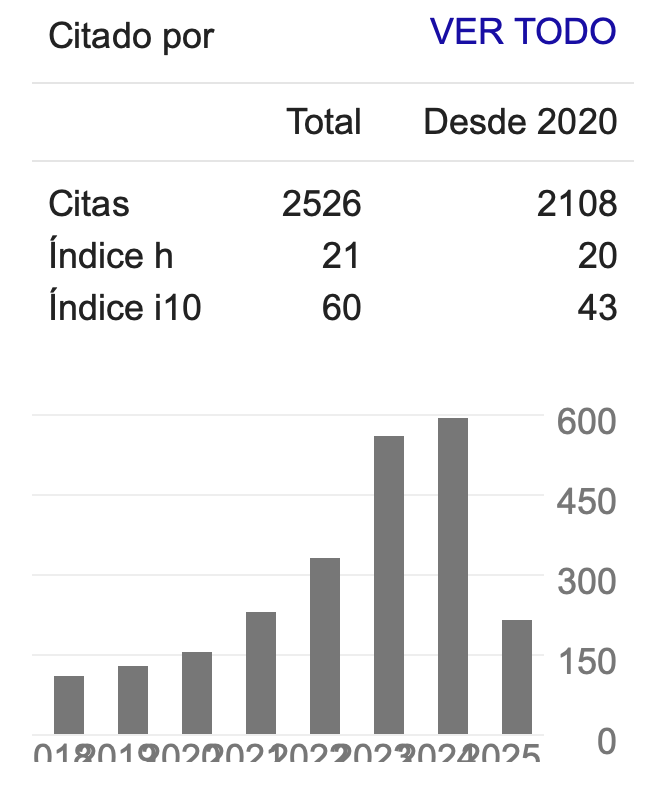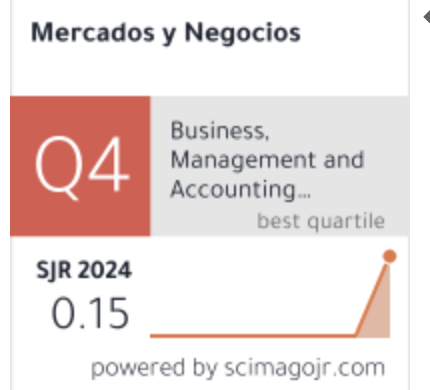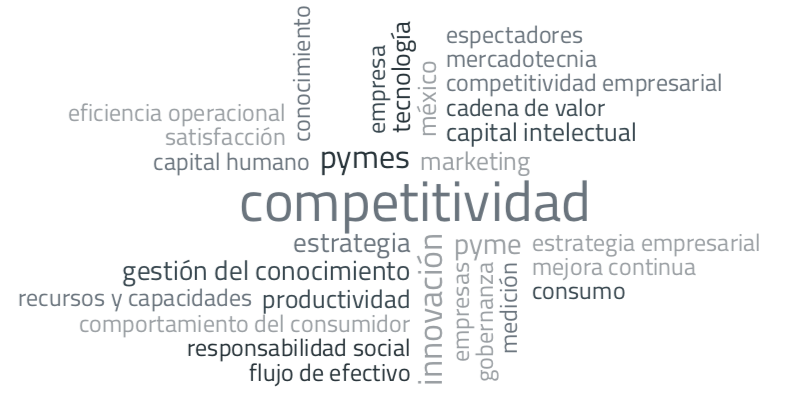La relación de la gestión de las cadenas de suministro con los procesos de producción para la competitividad de la pyme de Aguascalientes. Aguilera
DOI:
https://doi.org/10.32870/myn.v0i26.5227Keywords:
gestión de las cadenas de suministro, procesos de producción, competitividad, pyme.Abstract
Con el presente trabajo de investigación, aplicado a la pequeña y mediana empresa (pyme) del sector de manufactura se pretende explicar si existe una relación positiva entre la gestión de la cadena de suministro y los procesos de producción, con la finalidad de que sean más competitivas; para ello se aplicó un instrumento de evaluación dirigido a los gerentes, donde los resultados obtenidos se han analizado con apoyo del paquete estadístico eqs, donde a través de ecuaciones estructurales se ha dado respuesta al objetivo planteado. En este sentido se puede concluir que la gestión de las cadenas de suministro tiene una relación positiva con los procesos de producción, y a su vez esta relación muestra un impacto positivo en la competitividad de la pyme de Aguascalientes. Para esta investigación se ha utilizando una muestra de 120 empresas, las cuales contienen de cinco a 250 trabajadores.References
Akkermans, H., & Dellaert, N. (2005). The rediscovery of industrial dynamics: the contribution of system dynamics to supply chain management in a dynamic and fragmented world. System Dynamics Review, 21(3), 173-186.
Andersen, D. F., & Sturis, J. (1988). Chaotic structures in generic management models: Pedagogical principles and examples. System Dynamics Review, 4(1‐2), 218-245.
Anderson, E. G., Morrice, D. J., & Lundeen, G. (2005). The “physics” of capacity and backlog management in service and custom manufacturing supply chains. System Dynamics Review, 21(3), 217-247.
Anderson, J. C., & Gerbing, D. W. (1988). Structural equation modeling in practice: A review and recommended two-step approach. Psychological bulletin, 103(3), 411.
Anily, S. (1995). Single-machine lot-sizing with uniform yields and rigid demands: robustness of the optimal solution. IIE transactions, 27(5), 634-637.
Arntzen, B. C., Brown, C. G., Harrison, T. P., y Trafton, L. L. (1995). “Global Supply Chain Management at Digital Equipment Corporation
Bagozzi, R. P., & Yi, Y. (1988). On the evaluation of structural equation models. Journal of the academy of marketing science, 16(1), 74-94.
Bathelt, H., Malmberg, A., & Maskell, P. (2004). Clusters and knowledge: local buzz, global pipelines and the process of knowledge creation. Progress in human geography, 28(1), 31-56.
Blumenfeld, D. E., Burns, L. D., Daganzo, C. F., Frick, M. C., & Hall, R. W. (1987). Reducing logistics costs at General Motors. Interfaces, 17(1), 26-47.
Bozarth, C., & Chapman, S. (1996). A contingency view of time-based competition for manufacturers. International Journal of Operations & Production Management, 16(6), 56-67.
Bresnen, M. (1996). An organizational perspective on changing buyer-supplier relations: a critical review of the evidence. Organization, 3(1), 121-146.
Bryson, J., Henry, N., Keeble, D., & Martin, R. (1999). The economic geography reader. Wiley, Chichester and New York Bryson W (1993) Britain’s hedgerows. National Geographic, 182, 94-117.
Buckley, P. J., Pass, C. L., & Prescott, K. (1988). Measures of international competitiveness: A critical survey∗†. Journal of marketing management, 4(2), 175-200.
Cakravastia, A., Toha, I. S., & Nakamura, N. (2002). A two-stage model for the design of supply chain networks. International journal of production economics,80(3), 231-248.
Camagni, R. (1991). Introduction: from the local ‘milieu’to innovation through cooperation networks. Innovation networks: spatial perspectives, 1-9.
Chang, H. C. (2004). An application of fuzzy sets theory to the EOQ model with imperfect quality items. Computers & Operations Research, 31(12), 2079-2092.
Chang, S. C., Lin, R. J., Chen, J. H., & Huang, L. H. (2005). Manufacturing flexibility and manufacturing proactiveness: empirical evidence from the motherboard industry. Industrial Management & Data Systems, 105(8), 1115-1132.
Cho, Y. J., Leem, C. S., & Shin, K. T. (2008). The relationships among manufacturing innovation, competitiveness, and business performance in the manufacturing industries of Korea. The International Journal of Advanced Manufacturing Technology, 38(7-8), 840-850.
Chopra, S., & Meindl, P. (2007). Supply chain management. Strategy, planning & operation. In Das Summa Summarum des Management (pp. 265-275). Gabler.
Clark, A. J., & Scarf, H. (1960). Optimal policies for a multi-echelon inventory problem. Management science, 6(4), 475-490.
Clark, A. J., & Scarf, H. (1962). Approximate solutions to a simple multi-echelon inventory problem. Studies in applied probability and management science, 88-110.
Cohen, M. A., & Moon, S. (1990). Impact of production scale economies, manufacturing complexity, and transportation costs on supply chain facility networks. Journal of Manufacturing and Operations Management, 3(4), 269-292.
Daniel, J. S. R., & Rajendran, C. (2005). Determination of base-stock levels in a serial supply chain: a simulation-based simulated annealing heuristic.International Journal of Logistics Systems and Management, 1(2-3), 149-186.
Ettl, M., Feigin, G. E., Lin, G. Y., & Yao, D. D. (2000). A supply network model with base-stock control and service requirements. Operations Research, 48(2), 216-232.
Fornell, C., & Larcker, D. F. (1981). Evaluating structural equation models with unobservable variables and measurement error. Journal of marketing research, 39-50.
Gereffi, G. (1994). The Organization of Buyer-Driven Global Commodity Chains: How US Retailers Shape Overseas Production Networks. Commodity chains and global capitalism.
Giannoccaro, I., & Pontrandolfo, P. (2002). Inventory management in supply chains: a reinforcement learning approach. International Journal of Production Economics, 78(2), 153-161.
Gonçalves, P., Hines, J., & Sterman, J. (2005). The impact of endogenous demand on push–pull production systems. System dynamics review, 21(3), 187-216.
Hair, J. F., Anderson, R. E., & Tatham, R. L. (7). Black, WC (1995) Multivariate Data Analysis with Readings.
Heckler, C. E. (1996). A Step-by-Step Approach to Using the SAS™ System for Factor Analysis and Structural Equation Modeling. Technometrics, 38(3), 296-297.
Hicks, C., McGovern, T., & Earl, C. F. (2000). Supply chain management: A strategic issue in engineer to order manufacturing. International Journal of Production Economics, 65(2), 179-190.
Hines, P. (1996). Purchasing for lean production: the new strategic agenda.International Journal of Purchasing and Materials Management, 32(4), 2-10.
Husseini, S. M., O’brien, C., & Hosseini, S. T. (2006). A method to enhance volume flexibility in JIT production control. International Journal of Production Economics, 104(2), 653-665.
Ishii, K., Takahashi, K., & Muramatsu, R. (1988). Integrated production, inventory and distribution systems. The International Journal Of Production Research, 26(3), 473-482.
Kadadevaramath, R., Mohanasundaram, K. M., Sarath Chandra, P. S., & Rameshkumar, K. (2008). Optimizing Manufacturing and Supply Chain Operations in Logistics Management. The Icfai Journal of Supply Chain Management, 5(1).
Khouja, M. (1995). The economic production lot size model under volume flexibility. Computers & operations research, 22(5), 515-523.
Khouja, M., & Mehrez, A. (1994). An economic production lot size model with imperfect quality and variable production rate. Journal of the Operational Research Society, 45(12), 1405-1417.
Khouja, M., & Mehrez, A. (2005). A production model for a flexible production system and products with short selling season. Advances in Decision Sciences, 2005(4), 213-223.
Lamming, R. (1993). Beyond partnership: strategies for innovation and lean supply. Prentice Hall.
Lawrence, P. L. (1967). J.(1967), Organisation and Environment.
Lummus, R. R., Krumwiede, D. W., & Vokurka, R. J. (2001). The relationship of logistics to supply chain management: developing a common industry definition. Industrial Management & Data Systems, 101(8), 426-432.
Machorro, R. A., Panzi, U. M., & Cabrera, Z. G. (2007). Problemas que afectan la administración adecuada de los recursos tecnológicos en las pequeñas y medianas empresas. Academia Journals, 1(1), 1-7.
Maillat, D. (1995). Territorial dynamic, innovative milieus and regional policy.Entrepreneurship & Regional Development, 7(2), 157-165.
Maldonado-Guzman, G., Hernandez-Castorena, O., & Aguilera-Enriquez, L. (2012). THE RELATIONSHIP BETWEEN PRODUCTION PROCESS AND COMPETITIVENESS LEVEL IN MEXICAN SMEs: AN EMPIRICAL STUDY.Journal of Competitiveness Studies, 20(3/4), 3.
Martin, C. H., Dent, D. C., & Eckhart, J. C. (1993). Integrated production, distribution, and inventory planning at Libbey-Owens-Ford. Interfaces, 23(3), 68-78.
McGovern, T., Hicks, C., & Earl, C. F. (1998). A review of supply chain management issues in engineer to order supply. In Proceedings of the Seventh International Annual IPSERA Conference on Supply Strategies: Concepts and Practice at the Leading Edge (Vol. 5, No. 7, p. 376).
Mosekilde, E., & Larsen, E. R. (1988). Deterministic chaos in the beer production‐distribution model. System Dynamics Review, 4(1‐2), 131-147.
Nunnally, J. C. (81). Bernstein, IH (1994). Psychometric theory. New York: McGraw-Hill.
O'Farrell, P. N., Wood, P. A., & Zheng, J. (1998). Regional influences on foreign market development by business service companies: elements of a strategic context explanation. Regional studies, 32(1), 31-48.
Paik, S. K., & Bagchi, P. K. (2007). Understanding the causes of the bullwhip effect in a supply chain. International Journal of Retail & Distribution Management, 35(4), 308-324.
Petrovic, D., Roy, R., & Petrovic, R. (1998). Modelling and simulation of a supply chain in an uncertain environment. European journal of operational research, 109(2), 299-309.
Power And, D., & Hallencreutz, D. (2007). Competitiveness, local production systems and global commodity chains in the music industry: entering the US market. Regional Studies, 41(3), 377-389.
Prahalad, C. K., & Hamel, G. (2006). The core competence of the corporation. In Strategische unternehmungsplanung—strategische unternehmungsführung(pp. 275-292). Springer Berlin Heidelberg.
Porteus, E. L. (1986). Optimal lot sizing, process quality improvement and setup cost reduction. Operations research, 34(1), 137-144.
Ramírez, S. A., & Peña, G. E. (2011). Análisis de comportamiento caótico en variables de la cadena de suministro. Journal of Economics, Finance and Administrative Science, 16(31), 85-106.
Roberts, J. (1998). Multinational business service firms: development of multinational organization structures in the UK business service sector. Ashgate.
Robinson, E. P., Gao, L. L., & Muggenborg, S. D. (1993). Designing an integrated distribution system at DowBrands, Inc. Interfaces, 23(3), 107-117.
Salameh, M. K., & Jaber, M. Y. (2000). Economic production quantity model for items with imperfect quality. International journal of production economics,64(1), 59-64.
Sana, S. (2004). On a Volume Flexible Inventory Model. Advanced Modeling and Optimization, 6(2), 1-15.
Sana, S. S., Goyal, S. K., & Chaudhuri, K. (2006). On a volume flexible inventory model for items with an imperfect production system. International Journal of Operational Research, 2(1), 64-80.
Sana, S. S., Goyal, S. K., & Chaudhuri, K. (2007). An imperfect production process in a volume flexible inventory model. International Journal of Production Economics, 105(2), 548-559.
Singh, S., & Singh, S. R. (2008). Supply Chain Model for Perishable Item Having Exponentially Increasing Demand Rate Under Fixed Trade Credit.International Journal of Applied Mathematical Analysis and Application, 3(1), 107-118.
Singh, S. R., Singh, C., & Singh, T. J. (2008). Optimal ordering policy for decaying items with stock-dependent demand under inflation in a supply chain.International Review of Pure and Applied Mathematics, 4(1), 31-39.
Stalk Jr, G. (1988). Time—The Next Source of Competitive Advo nioge.Harvard business review, 41.
Siajadi, H., Ibrahim, R. N., & Lochert, P. B. (2006). Joint economic lot size in distribution system with multiple shipment policy. International Journal of Production Economics, 102(2), 302-316.
Stapleton, D., Hanna, J. B., & Ross, J. R. (2006). Enhancing supply chain solutions with the application of chaos theory. Supply Chain Management: An International Journal, 11(2), 108-114.
Sterman, J. D. (1989). Modeling managerial behavior: Misperceptions of feedback in a dynamic decision making experiment. Management science,35(3), 321-339.
Storper, M., & Venables, A. (2002). Buzz: the economic force of the city, paper delivered to the International Seminar on Space and Economy. Ouro Preto, Brazil.
Strambach, S. (2002). Change in the Innovation Process: New Knowledge Production and Competitive Cities--The Case of Stuttgart. European planning studies, 10(2), 215-231.
Thomas, D. J., & Griffin, P. M. (1996). Coordinated supply chain management.European journal of operational research, 94(1), 1-15.
Truong, T. H., & Azadivar, F. (2003, December). Simulation optimization in manufacturing analysis: simulation based optimization for supply chain configuration design. In Proceedings of the 35th conference on Winter simulation: driving innovation (pp. 1268-1275). Winter Simulation Conference.
Turnbull, P., Oliver, N., & Wilkinson, B. (1992). Buyer‐supplier relations in the UK‐automotive industry: Strategic implications of the Japanese manufacturing model. Strategic Management Journal, 13(2), 159-168.
Urban, T. L. (1992). Deterministic inventory models incorporating marketing decisions. Computers & industrial engineering, 22(1), 85-93.
Weber, C. A., & Desai, A. (1996). Determination of paths to vendor market efficiency using parallel coordinates representation: a negotiation tool for buyers. European Journal of Operational Research, 90(1), 142-155.
Wisner, J. D. (2003). A structural equation model of supply chain management strategies and firm performance. Journal of Business Logistics, 24(1), 1-26.
Williams, J. F. (1981). Heuristic techniques for simultaneous scheduling of production and distribution in multi-echelon structures: Theory and empirical comparisons. Management Science, 27(3), 336-352.
Downloads
Published
How to Cite
Issue
Section
License
Mercados y Negocios by Department of Mercadotecnia y Negocios Internacionales. University of Guadalajara is licensed under a License Creative Commons Attribution-NonCommercial 4.0 International.
The author retains the copyright.








